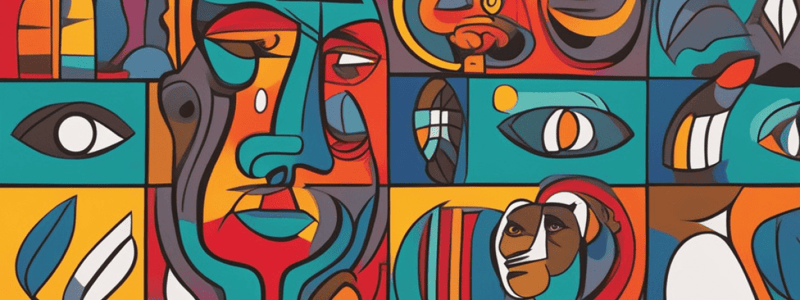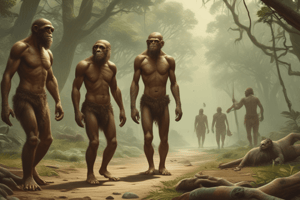Podcast
Questions and Answers
Which major group of early humans showed a significant shift towards human-like traits, particularly consistent bipedal locomotion?
Which major group of early humans showed a significant shift towards human-like traits, particularly consistent bipedal locomotion?
- Australopithecines (correct)
- Homo species
- Early hominins
- Chimpanzees
What is one key characteristic that differentiated Homo species from australopithecines and early hominins?
What is one key characteristic that differentiated Homo species from australopithecines and early hominins?
- Small brains
- Bipedal locomotion
- Large canines
- Sophisticated stone tool technology (correct)
Which group of early humans showed characteristics like small canines but retained many ape-like traits?
Which group of early humans showed characteristics like small canines but retained many ape-like traits?
- Early hominins (correct)
- Chimpanzees
- Australopithecines
- Homo species
What is one significant achievement of Homo species that helped differentiate them from earlier hominins?
What is one significant achievement of Homo species that helped differentiate them from earlier hominins?
Which hominin group is the only one that remains today, shaped by millions of years of evolution?
Which hominin group is the only one that remains today, shaped by millions of years of evolution?
What major event allowed Homo species to be the first to migrate out of Africa and explore other parts of the world?
What major event allowed Homo species to be the first to migrate out of Africa and explore other parts of the world?
What significant shift towards human-like traits did the australopithecines show?
What significant shift towards human-like traits did the australopithecines show?
Which hominin group became increasingly human-like with larger cranial capacity and sophisticated stone tool technology?
Which hominin group became increasingly human-like with larger cranial capacity and sophisticated stone tool technology?
What enabled Homo species to be the first hominins to migrate out of Africa and explore other parts of the world?
What enabled Homo species to be the first hominins to migrate out of Africa and explore other parts of the world?
Which hominin group is the only one that remains today, shaped by millions of years of evolution?
Which hominin group is the only one that remains today, shaped by millions of years of evolution?
What is a distinguishing physical characteristic of Neanderthals?
What is a distinguishing physical characteristic of Neanderthals?
What is one similarity between Neanderthals and modern humans?
What is one similarity between Neanderthals and modern humans?
What geographical regions were inhabited by Neanderthals?
What geographical regions were inhabited by Neanderthals?
What percentage of DNA in Europeans and Asians is suspected to be from interbreeding with Neanderthals?
What percentage of DNA in Europeans and Asians is suspected to be from interbreeding with Neanderthals?
When was the first neanderthal fossil officially recognized as a neanderthal?
When was the first neanderthal fossil officially recognized as a neanderthal?
What physical traits of Neanderthals helped them adapt to cold environments?
What physical traits of Neanderthals helped them adapt to cold environments?
In what ways did Neanderthals demonstrate cultural advancement?
In what ways did Neanderthals demonstrate cultural advancement?
What is a notable similarity between Neanderthals and modern humans in terms of brain size?
What is a notable similarity between Neanderthals and modern humans in terms of brain size?
Which behavior indicates a social aspect of Neanderthals' culture?
Which behavior indicates a social aspect of Neanderthals' culture?
What is the significance of the discovery of Neanderthal DNA in Europeans and Asians?
What is the significance of the discovery of Neanderthal DNA in Europeans and Asians?
What aspect of Neanderthals' anatomy differentiated them from modern humans?
What aspect of Neanderthals' anatomy differentiated them from modern humans?
What are the two major categories of fossils mentioned in the text?
What are the two major categories of fossils mentioned in the text?
How does amber fossilization preserve organisms?
How does amber fossilization preserve organisms?
What is NOT a method of fossilization that transforms soft tissues into carbon films?
What is NOT a method of fossilization that transforms soft tissues into carbon films?
What is NOT a method of fossilization that provides crucial information like identifying tree genus from wood?
What is NOT a method of fossilization that provides crucial information like identifying tree genus from wood?
How do footprints in the fossil record contribute to our understanding of ancient life?
How do footprints in the fossil record contribute to our understanding of ancient life?
What is the main difference between body fossils and trace fossils?
What is the main difference between body fossils and trace fossils?
How does permineralization differ from frozen fossilization?
How does permineralization differ from frozen fossilization?
What is a key benefit of having insects preserved in amber?
What is a key benefit of having insects preserved in amber?
What is NOT one method of fossilization that changes the specimen's original form?
What is NOT one method of fossilization that changes the specimen's original form?
How does carbonization differ from permineralization in terms of soft tissue transformation?
How does carbonization differ from permineralization in terms of soft tissue transformation?
What are the primary countries where around 400 cave art-filled sites have been discovered?
What are the primary countries where around 400 cave art-filled sites have been discovered?
What is the typical color of pigments used for cave art, as mentioned in the text?
What is the typical color of pigments used for cave art, as mentioned in the text?
What is one debated reason for the creation of cave art mentioned in the text?
What is one debated reason for the creation of cave art mentioned in the text?
Which animals are predominantly depicted in the majority of cave art mentioned in the text?
Which animals are predominantly depicted in the majority of cave art mentioned in the text?
What do some of the artworks drawn on cave walls or engraved into stone follow, as mentioned in the text?
What do some of the artworks drawn on cave walls or engraved into stone follow, as mentioned in the text?
What is the typical age range of most cave art, as mentioned in the text?
What is the typical age range of most cave art, as mentioned in the text?
Which animals are NOT predominantly depicted in the majority of cave art sites mentioned in the text?
Which animals are NOT predominantly depicted in the majority of cave art sites mentioned in the text?
What were the two primary colors of pigments used for cave art, according to the text?
What were the two primary colors of pigments used for cave art, according to the text?
What was one debated reason for the creation of cave art, as mentioned in the text?
What was one debated reason for the creation of cave art, as mentioned in the text?
How were the artworks typically applied to cave walls, based on the information provided?
How were the artworks typically applied to cave walls, based on the information provided?
is Quizgeco's ai DUMB?
is Quizgeco's ai DUMB?
Flashcards are hidden until you start studying
Study Notes
- Approximately seven million years ago, the human lineage split from that of chimpanzees, marking the beginning of humanity's evolution.
- Over 20 early human species or hominins emerged, with some becoming extinct and others potentially being ancestors to modern humans.
- These hominins displayed varying degrees of human-like physical and behavioral traits, such as large brains, small teeth, bipedality, and tool use.
- Early humans are divided into three major groups: early hominins, australopithecines, and the homo genus.
- Early hominins, who lived between seven and 4.4 million years ago in Africa, retained many ape-like traits but showed early human-like characteristics like small canines.
- Australopithecines, living between 4.4 and 1.4 million years ago, showed a significant shift towards human-like traits, particularly consistent bipedal locomotion.
- Homo species, dating back over two million years ago, became increasingly human-like with larger cranial capacity, sophisticated stone tool technology, and control of fire.
- Homo species were the first to migrate out of Africa and explore the rest of the world.
- Only one hominin species remains today: Homo sapiens, shaped by millions of years of evolution and embarked on a journey of exploration and industry.
Studying That Suits You
Use AI to generate personalized quizzes and flashcards to suit your learning preferences.



